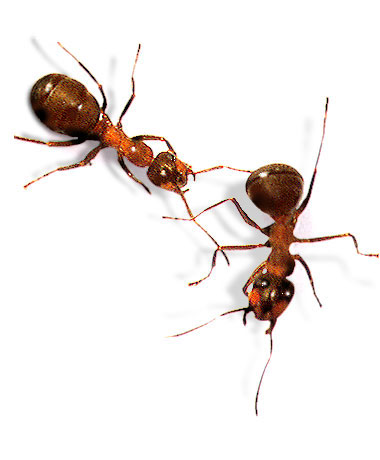Ants
Ants are of the family Formicidae
Ants
Ants in Australia ~ The ant fauna of Australia is especially large and diverse. World-wide, there are 16 subfamilies, about 300 genera and about 15,000 described species and subspecies of ants. Australia is currently known to have representatives of 10 subfamilies, 101 genera and 1275 described species and subspecies.
Ants are insects and like all insects the body has three main parts; the head, the thorax (middle section), and the abdomen. Ants have six legs and they are attached to the thorax. The head is made up of the jaws, the eyes, and the antennae. The eyes of ants are made up of many lenses and are called compound eyes. Compound eyes make it possible for ants to see movement very well.
An ant’s antennae are special organs used by the ant to smell, touch, taste, and hear. In the abdomen are the ant’s stomach and rectum. Many species (kinds) of ants have poison sacks and/or stingers in the end of the abdomen for defense against predators (enemies)
Ants breathe through tiny holes all over their body. The ant’s heart is a long tube that pumps colourless blood from the head back to the abdomen and then back up to the head again.
Did you know?
Ants live in large colonies or groups. Their home is a nest. There may be up to a million ants in a large nest. In each colony there are three types of ants: the queen, the female workers, and males. The male ants’ job is to mate with queen ants so that they will be able to lay eggs. Male ants don’t live very long.
There may be as many as 20,000 different species of ants.
Ants have six legs and they are attached to the thorax.
The female is the larger ant
Many species (kinds) of ants have poison sacks and/or stingers in the end of the abdomen for defense against predators (enemies)
The queen grows to be an adult, mates with a male, then spends the rest of her life laying eggs. In a colony there may be only one queen or there may be many queens, depending on the species. The worker ants do all the work in the nest. They build it and clean it, gather food, look after the queen, the eggs, and the young ants. Worker ants also defend the nest.
Life cycle
Ants go through four stages: egg, larva, pupa, and adult.
Different kinds of ants build different types of nests. Some build simple mounds of dirt or sand. Others use small sticks mixed with dirt and sand to make stronger and waterproof mounds. Inside the nest there are many chambers (or rooms). The chambers are connected to each other by tunnels. Chambers are used for different things, for example as nurseries for eggs and young ants, for storing food, as resting places for the worker ants and a there’s a special chamber just for the queen.
Ants communicate (talk to each other) by touching each other with their antennae. They also use chemicals called pheromones to leave a trail of scent for other ants to follow.
Ants have lived on the Earth for more than 100 million years and can be found almost anywhere on the planet.
Go to this kidcyber page to read about leafcutter ants:

